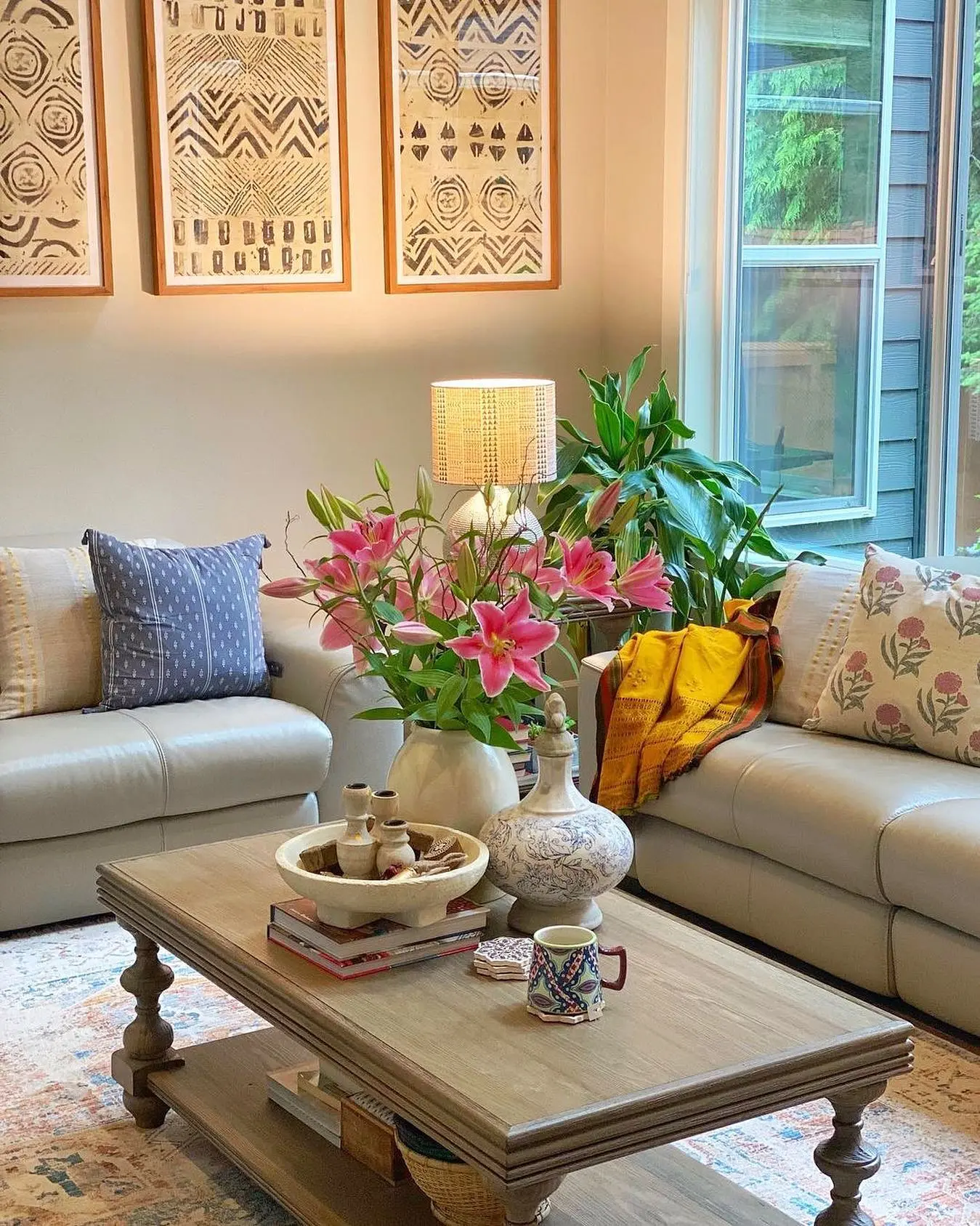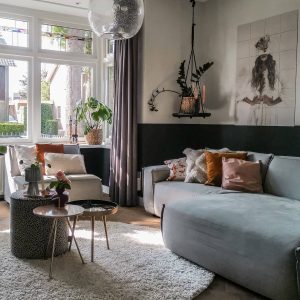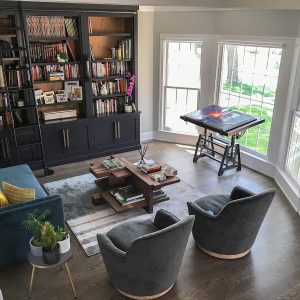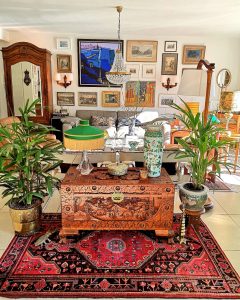‘How To Style Eclectic Accessories In Your Home,’ explores the exciting journey of enhancing your living spaces with unique and varied accessories. The eclectic style is celebrated for its diversity and personal touch, making each room a true reflection of individual personality and taste.
This post is packed with essential insights and practical tips. From understanding the fundamental principles of eclectic decor to choosing and arranging accessories that complement your aesthetic, our goal is to help you transform your space into an engaging and comfortable haven.
As we delve into the nuances of selecting the right accessories, integrating them thoughtfully into each room, and maintaining a harmonious balance within your eclectic decor, you will discover how to craft a home that is both stylish and distinctly your own.
How To Style Eclectic Accessories In Your Home
Let’s explore how to mix textures, colors, and historical periods to achieve a dynamic yet cohesive home interior.
Understanding the Basics of Eclectic Decor Styling Principles
Eclectic styling in home decor is all about freedom and the joyful mixing of styles, textures, and periods to create a space that is uniquely yours. Unlike more traditional approaches that stick to a single aesthetic, eclectic interiors are characterized by their diversity and personalized approach. However, to do eclectic right, it’s essential to have a foundational understanding that helps balance this diversity without your space feeling chaotic.
What Is Eclectic Decor?
At its heart, eclectic decor is about harmony and contrast. It combines elements from different design periods, styles, and cultures, relying on color, texture, and composition to bring cohesion to diverse elements. The goal is to create a space that feels curated rather than cluttered, where every piece has its place and significance.
To learn more about this style, refer to our post on What Is Eclectic Decor? An Ultimate Guide to Eclectic Style.
The Role of Accessories in Eclectic Decor
In the realm of eclectic styling, accessories are not just decorative—they are pivotal in defining the room’s character and atmosphere. These might include a range of items from plush throw pillows and antique lamps to modern sculptures and rustic baskets. Each accessory contributes to the narrative of the space, telling a story through its historical significance, texture, or color.
Transitioning to Practical Application
Understanding the theory behind eclectic decor is just the beginning. The real creativity comes into play when you start integrating this style into your home. Here are a few pointers to ensure that your approach to eclectic styling remains both stylish and structured:
- Start with a Neutral Base: Begin with neutral walls and flooring to ground the space. This backdrop will make it easier to mix and match different styles without creating visual noise.
- Mix Textures Thoughtfully: Combining various textures like metal, wood, glass, and fabric can add depth to your room. However, ensure that there is a balance so that no single texture overwhelms the others.
- Incorporate Color with Care: While eclectic decor often involves a bold use of color, it’s crucial to have a somewhat consistent color palette that helps tie different elements together.
- Play with Scale and Proportion: Use a variety of scales in your decorative pieces to create interest and keep the eye moving around the room. A large painting on one wall might be balanced by a collection of smaller photographs on another.
Selecting Eclectic Accessories for Your Home
Selecting the right accessories is crucial in eclectic decor because these items are more than just embellishments; they serve as the keystones that can tie disparate elements together and create a harmonious space. When done right, eclectic accessories can transform a room from plain to stylistically complex and visually interesting.
Guidelines for Selecting Eclectic Accessories
To choose accessories that will not only stand out but also harmonize with your existing decor, consider these guidelines:
- Select with Intention: Every piece should have a purpose, whether it’s to add a splash of color, introduce texture, or serve as a focal point. Avoid choosing items solely because they are trendy; select them because they resonate with your personal style.
- Focus on Authenticity: Opt for genuine items that hold some personal or historical significance. This could be a hand-woven basket from a local artisan, a vintage rug from an antique store, or a family heirloom.
- Balance Old and New: Mix modern pieces with vintage finds for a look that feels both timeless and grounded. This contrast is what often defines an eclectic style.
Types of Eclectic Accessories
Here are some specific types of accessories that work well in an eclectic interior:
- Art from Various Eras: A mix of classical paintings, modern abstract art, and contemporary prints can coexist beautifully if they share a common element, such as color scheme or subject matter.
- Global Artifacts: Items like tribal masks, handcrafted pottery, or exotic textiles can add an international dimension to your decor.
- Vintage Pieces: Antique mirrors, old typewriters, or vintage books can add a sense of history and depth to your rooms.
- Modern Artifacts: Contemporary sculptures or minimalist clocks can help balance older elements and give the space a fresh feel.
- Natural Elements: Consider incorporating plants, stones, wood pieces, or coral, which can bring life and a touch of nature into your home.
Using Color and Texture to Select Accessories
The use of color and texture is especially important in eclectic decorating:
- Color: Choose accessories that either complement or thoughtfully contrast with the room’s color palette. If your room features mostly warm tones, a cool-toned sculpture might provide a striking contrast that draws the eye.
- Texture: Mixing textures can add depth and interest. For instance, a smooth, shiny metal lamp placed next to a rough, woven basket creates a dynamic look that invites touch and exploration.
Room-by-Room Guide to Styling Eclectic Accessories
Eclectic accessories can transform any room, but the key to success lies in how these pieces are integrated into the space. Each room in your home serves a different function and thus provides unique opportunities for eclectic styling. Let’s explore some room-specific strategies to effectively incorporate eclectic accessories.
Living Room
The living room is often the centerpiece of a home, a place for relaxation and socializing. Here’s how to integrate eclectic accessories effectively:
- Mix and Match with Purpose: Combine various stylistic elements, like a modern sofa with vintage lamps and a rustic coffee table. This mix should feel intentional, not haphazard.
- Create a Focal Point: Use a large, bold piece, such as an oversized art print or an antique mirror, to draw attention and anchor the room.
- Layer Different Textures: Add depth by layering textures—place silky cushions on a leather couch or a soft, furry throw on a sleek modern chair.
Bedroom
The bedroom should be a personal sanctuary, reflecting individual taste and comfort. Eclectic accessories here should contribute to a restful environment:
- Personalize with Art and Photographs: Display art or photos that are meaningful to you, which can range from family portraits to abstract paintings.
- Incorporate Soft Furnishings: Use a variety of textiles, like a quilted bedspread, knitted throws, and plush rugs, to add comfort and warmth.
- Choose Soothing Colors: While eclectic can be bold, in the bedroom, it’s often wise to opt for calming colors in your accessories to promote relaxation.
Kitchen and Dining Area
The kitchen and dining area are spaces of function but also provide a canvas for creativity:
- Functional Decor: Utilize items like colorful ceramic pitchers, antique spice racks, and unique salt and pepper shakers that are both decorative and useful.
- Display Collections: If you collect certain items, such as vintage plates or artisanal cutting boards, display them openly on shelves or hanging racks.
- Add Unexpected Elements: Place a sculptural fruit bowl on the counter or hang a modern piece of art in the dining area to integrate a sense of surprise and interest.
Bathroom
Small touches in the bathroom can make a big impact, allowing for both beauty and functionality:
- Use Accent Pieces: A vintage mirror, a unique vase filled with fresh flowers, or artisanal soap dishes can elevate the look of your bathroom.
- Incorporate Textiles: Add eclectic flair with patterned shower curtains, luxurious towels, or a small, ornate rug.
- Keep It Functional: Remember that bathroom accessories should not only look good but also contribute to the functionality of the space.
Styling Tips for adding Eclectic Accessories to Your Home
Once you have selected eclectic accessories that resonate with your style and gathered them for different rooms, the next step is to style these items in a way that enhances the overall aesthetic of your home. Here are some essential styling tips to help you effectively arrange and showcase your eclectic accessories.
Balancing Colors, Textures, and Patterns
Achieving a balanced look with eclectic accessories involves a thoughtful mix of colors, textures, and patterns:
- Color Coordination: Use a consistent color palette throughout the room to tie different styles and periods together. This doesn’t mean all items must match, but they should complement each other. For example, if you have a vibrant, patterned rug, you might choose artwork or throw pillows that pick up colors from the rug.
- Mixing Textures: Combine various textures to create depth and interest. Place smooth ceramics alongside rough, natural wood, or pair shiny metals with matte fabrics. This variety will engage the senses and add character to the room.
- Pattern Play: Patterns should be mixed with care. Combine large prints with smaller ones and vary the scale to keep the eye moving. Ensure there is enough space or neutral color to prevent the patterns from clashing.
Mixing Eras and Styles Without Clashing
Integrating pieces from different eras and styles is a hallmark of eclectic decor, but doing it well requires a keen eye:
- Find Common Ground: Look for common features between items, such as shape, color, or texture, that can serve as a linking element.
- Balance Proportions: Ensure that items from different eras complement rather than overpower each other. A large antique cabinet, for instance, can be balanced with several smaller contemporary pieces around it.
- Limit Focal Points: While it’s tempting to fill a room with standout pieces, too many can create visual chaos. Choose one or two main focal points per room and let other items support these.
Creating Focal Points Using Bold Pieces
Focal points draw attention and can define the ambiance of a room:
- Go Bold: Choose bold pieces that can act as the centerpiece of a room, such as a large artwork, a colorful furniture piece, or an unusual light fixture.
- Placement Matters: Position these bold items where they can be appreciated, such as hanging a distinctive painting over the fireplace or using a dramatic vase in the center of the dining table.
- Keep It Balanced: Ensure the rest of the room supports the focal point without competing with it. Subtler accessories should complement and enhance the standout piece.
Layering and Scaling Accessories for Harmony
Layering and scaling are crucial for a harmonious eclectic look:
- Layer Strategically: Start with larger items in the back and smaller items in the front when arranging collections. Use shelves, tables, and even the floor to create layers that add to the room’s depth.
- Scale With Care: Keep items in proportion to their surroundings. A tiny lamp on a large table can look lost, while a too-large sofa in a small room can feel overwhelming. Scale accessories to fit the furniture and space they accompany.
How to Achieve Balance with Eclectic Home Styling
While eclectic styling allows for a broad range of creativity, maintaining aesthetic balance is crucial to prevent your space from becoming visually overwhelming. This balance involves knowing when to add or remove elements, how to choose which pieces stay, and when simplicity might be the best choice. Here are some tips to help you maintain a cohesive yet dynamic eclectic decor in your home.
Avoiding Over-decoration
Eclectic decor thrives on variety, but there’s a fine line between eclectic and chaotic:
- Curate Thoughtfully: It’s essential to be selective about what you display. Not every piece you own needs to be visible at all times. Rotate your accessories to keep the decor fresh without overloading your space.
- Leave Breathing Room: Ensure each piece has enough space around it to be appreciated fully. Crowding too many items together can make your space feel cramped and cluttered.
- Focus on Quality Over Quantity: Opt for fewer, higher-quality pieces rather than filling your space with many lesser items. This approach emphasizes the unique nature of each piece and adds a touch of luxury.
Deciding When Less is More
In eclectic decor, sometimes less is indeed more. This principle can be particularly effective in smaller spaces or in rooms where function is as important as form:
- Simplify the Palette: If you have a variety of textures and styles, consider simplifying the color palette. Using shades of the same color or complementary colors can create unity and allow your eclectic elements to shine without overwhelming the senses.
- Reduce Visual Weight: If a room feels too busy, consider removing some larger or darker items. Lighter and smaller pieces can give the space a more open feel, making the room appear larger and more inviting.
Reassessing and Rotating Your Decor
Keeping your decor dynamic and engaging over time means regularly reassessing and possibly rotating your accessories:
- Seasonal Changes: Adjust your decor with the seasons. For example, lighter fabrics and brighter colors can be refreshing in the spring and summer, while richer tones and heavier textures can be cozy in the fall and winter.
- Reflect on Your Space: Every once in a while, take a step back and look at your rooms with fresh eyes. Ask yourself if the current setup works or if it’s time for a change. This can involve shifting furniture, swapping out accessories, or even repainting walls to better complement your eclectic collection.
- Incorporate New Finds: As you acquire new pieces, consider which older items they might replace or complement. This ongoing process keeps your space interesting and personally meaningful.
DIY Ideas for Personalizing Your Home with Eclectic Accessories
Adding a personal touch to your home decor can make your space feel even more special and tailored to your taste. DIY projects are a perfect way to incorporate unique elements into your eclectic style, allowing for customization that reflects your personality and creativity. Here are some simple yet impactful DIY ideas that can help you personalize your eclectic accessories.
Simple DIY Ideas to Customize Your Accessories
- Hand-Painted Ceramics: Give new life to plain ceramic vases or pots by painting them with your designs. Use acrylic paints to create patterns or scenes that match your decor. This can be a fun activity to do with family or friends and makes each piece one-of-a-kind.
- Reupholster Vintage Furniture: Find a piece of vintage furniture at a thrift store or flea market and reupholster it with a modern fabric. This project blends old and new styles, providing a fresh look while keeping the vintage charm.
- Create Custom Lampshades: Customize lampshades with fabric, beads, or even hand-painted details to match your room’s color scheme and style. This small change can make a significant impact on the ambiance of a room.
- Decorative Wall Art: Use mixed media to create unique wall art. Combine paint, fabric, and recyclable materials to craft artworks that can serve as focal points in any room.
- Refresh Old Frames: Take old or mismatched picture frames and paint them in coordinating colors or gold leaf for a luxurious touch. These can be used to frame new art, family photos, or even preserved leaves and flowers.
Encouraging Creativity and Personal Expression Through DIY
DIY projects not only personalize your space but also offer an opportunity to express your creativity. Here’s how you can make the most out of your DIY endeavors:
- Choose Projects That Speak to You: Pick DIY projects that you are excited about. If you love a particular color or pattern, find ways to incorporate that into your projects.
- Experiment: Feel free to experiment with new techniques or materials. Eclectic style is all about mixing different elements, so this is your chance to experiment without much risk.
- Involve Others: DIY projects can be more enjoyable and enriching when done with others. They can also be a great way to spend time with children or friends, allowing everyone to contribute their ideas and creativity.
Conclusion
Frequently Asked Questions
1. How do I prevent my eclectic decor from looking cluttered?
Achieving a balance between eclectic variety and aesthetic clarity involves several strategies. First, curate your accessories thoughtfully, selecting items that truly speak to you rather than filling space for the sake of it. Pay attention to balance and proportion by mixing large statement pieces with smaller, more subtle items. Designate one or two focal points in each room to guide the arrangement of other pieces, and use negative space effectively. Allowing some areas to remain unadorned can prevent the decor from feeling overwhelming and gives your space a cleaner, more organized look.
2. How often should I change or rotate my accessories?
The frequency of changing or rotating accessories in an eclectic decor scheme can vary based on personal preference and lifestyle. Some prefer seasonal changes to reflect the time of year, offering a way to refresh the ambiance regularly. Others may choose to update their accessories when they find new pieces that capture their interest or when the room’s layout needs a refresh. Additionally, rotating accessories for special occasions or holidays can keep your home feeling current and engaging.
3. How do I mix modern and antique elements without clashing?
Mixing modern and antique elements requires a focus on creating a dialogue between contrasting styles. Identify common features, such as color, shape, or finish, that can link modern and antique elements together. Consider contrasting textures as a way to highlight the unique qualities of each piece, such as pairing a sleek, modern metal table with a plush antique chair. Ensure that both modern and antique items are distributed throughout the space rather than clustered, which helps integrate the styles and prevents any one style from dominating the room.
Related Posts:
- How to Incorporate Vintage Eclectic Design in a Modern Space
- Eclectic Textiles for Every Room: How to Incorporate Them in Unique Ways
- How To Create Balance In Eclectic Decor: Fundamental Principles
- How to Choose the Right Color Palette for Your Eclectic Home




